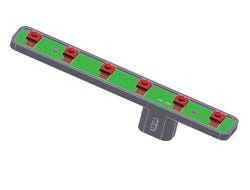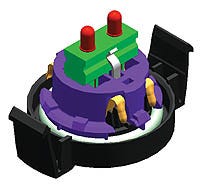42V: The new automotive molding challenge
December 1, 2001
Automotive electronics molders are getting ready for a major system shift that will push products such as lighting, switches, and connectors to the limit. We're talking about the planned conversion from 12 to 42V electrical systems, which automakers believe will allow them to create more efficient engines and more intelligent vehicles. First expected among high-end models from automakers such as BMW and DaimlerChrysler, initial 42V vehicles may appear as early as 2003.
While it is a boon for engine design, the new electrical system will tax existing molded parts to a certain extent. IMM asked Tricon Industries, a Tier Two automotive lighting and electronics supplier, to explain how the new electrical systems will impact molders in this industry. Tricon is already meeting the challenge head-on with innovative concept designs.
|
Tricon's center high mounted stop lamp (CHMSL) design concept makes use of LEDs to be completely compatible with 42V systems. A component with a similar design could be in production within a year. |
Jeff Terrell, product development manager for Tricon, explains that customers such as Delphi are developing components based on these concepts. "Our customers will ultimately do the design work for these products," he adds, "but we have been researching 42V systems and creating some preliminary concepts to make the transition easier."
|
This universal wedge design for a stop-signal LED lamp is fully compatible with the 42V system and is also a drop-in replacement for incandescent bulbs. |
New Demands
One of the new requirements for a 42V system will be that connectors and lighting components must exhibit a high degree of arc resistance. Under heavy load, the higher-voltage system can develop severe arcing that may erode metal contacts. "Any power system under 16V has no sustainable arcing," Terrell says, "but anything over 16V has a known arc for a specified distance. With 42V systems, if you unplug a connector that is under power, it will arc."
Arcing can occur even if the components are only slightly disconnected. As a result, new products will need to incorporate locking mechanisms as well as a way to eliminate arcing. Tricon is looking at an insert molding method that combines two magnets in the connector to disrupt the arc. In addition, designs that have molded-in locking mechanisms are being investigated.
Incandescent light bulbs are another area that must be addressed in the new systems. As voltage goes up, bulb life decreases significantly. While research is under way to produce a longer-lasting incandescent bulb, Tricon is investigating systems that use LEDs. "Each LED bulb requires only 2 to 4V of electricity," Terrell says. "We are working on designs that use multiple LEDs that will provide the amount of light needed." LED bulbs can be connected in a series with a voltage step-down resistor.
By comparison, materials are predicted to remain the same. "Existing base plastic materials should be able to meet flammability and temperature resistance requirements," Terrell says, "mainly because the heat generation will be the same." Although higher voltages are being used, the amps or current will decrease so that the temperatures the parts see will remain constant.
A primer on 42V What do automakers hope to achieve with a 42V electrical system? One of the main objectives centers on a more fuel-efficient engine, made possible with integrated starter-alternators and electromechanical engine valves. Other power-hungry additions may include electric brakes and active suspensions. The new system will most likely first appear as a dual battery combination (both a 12 and 36V) to ease the transition for components based on the older system. Generator output will also triple from 14 to 42V. More than 40 years ago, automakers switched from a 6V battery to the current 12V system. Today's option-filled vehicles have reached the limit of this power source. In addition, wiring harnesses have overtaken underhood space. The reason? Power is the product of amps (current) times voltage. With a lower voltage, current is high, requiring thick cables and harnesses that clog underhood space. As voltage goes up, the current requirement goes down, which allows designers to reduce wiring and component sizes. From an environmental standpoint, the new electrical system holds the promise of more efficient vehicles. For instance, some industry observers predict that the higher-voltage battery will not only reduce weight but will also accelerate the development and widespread acceptance of hybrid gas/electric vehicles. Also, if the integrated starter-alternator materializes, it could allow cars to operate like golf carts, shutting down and restarting rather than idling at stoplights. |
Higher-voltage Concepts
With a 42V system, off-the-shelf items such as standard switches, connectors, and lighting components may become obsolete. "More of these parts will require a custom approach," he says. "For example, encapsulation will likely become more common as a way to protect higher-voltage components from arcing or shorting." Tricon is investigating the MuCell process (microcellular foam molding) as a means of encapsulating sensitive electronics such as PC boards and solid-state switches.
Another concept under development is a longer-life CHMSL (center high mounted stop lamp, pronounced chim-sul). It incorporates LEDs for greater life span in a 42V system. According to Terrell, heat issues are being addressed through design innovation. "One downside of new, high-intensity LEDs is that the hotter they are, the less light is transmitted. We are working on designs that incorporate a metal heat sink to draw heat away from the bulb." He estimates that Tricon could have an LED-based CHMSL in production within one year.
Finally, a drop-in LED replacement for incandescent bulbs in stop lamps, called a Universal Wedge, is also on the drawing board. The design works with all existing backplate and socket configurations, eliminating the need for any retooling.
Contact information |
You May Also Like




